I just returned from Lake Chabot Gun Club – great day in the country, spent enjoyable time with family, and had an opportunity to break in a couple of new rifles. The day started off with an overcast sky, but by 9:30 or so the sun was out, and the expansive firing lines at Chabot were packed full of shooters enjoying a favorite pastime. There was even a group of Civil War buffs, Union side I believe, shooting black powder rifles and dragging along a vintage Gatling gun.
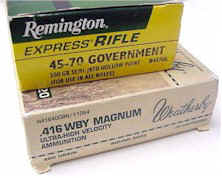 While I had planned to shoot both the .416 Weatherby Euromark, and the .45/70 Marlin 1885G, the .45/70 almost didn’t make the trip. Contrary to what I’d anticipated, .416 ammo was easy to locate, but inexpensive Remington and Winchester brand .45/70 ammo were not. In fact, even my .45/70 reloading die set ended up on 30 day backorder along with other related equipment. I assume these shortages are related to the recent resurgence in popularity of this cartridge. The appearance of numerous guns with strong actions and performance loads have really benefited this cartridge. Fortunately, I found ammo at the last place I looked, 60 miles away at the range…duh.
While I had planned to shoot both the .416 Weatherby Euromark, and the .45/70 Marlin 1885G, the .45/70 almost didn’t make the trip. Contrary to what I’d anticipated, .416 ammo was easy to locate, but inexpensive Remington and Winchester brand .45/70 ammo were not. In fact, even my .45/70 reloading die set ended up on 30 day backorder along with other related equipment. I assume these shortages are related to the recent resurgence in popularity of this cartridge. The appearance of numerous guns with strong actions and performance loads have really benefited this cartridge. Fortunately, I found ammo at the last place I looked, 60 miles away at the range…duh.
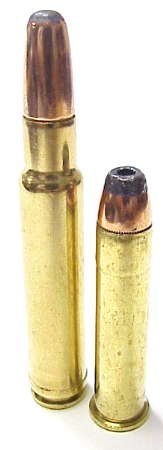 I liked the idea of checking out a couple of big bore rifles. The Weatherby Euromark retails for about $2,000, the Marlin at about $595. Both can be had for 15% – 25% less with a little shopping around. I delayed one year too long to purchase the Weatherby. Through 1999, the Euromark with it’s European oil finish stock and matte metal parts, was sold at a substantially lower price than the Weatherby Deluxe. This year Weatherby apparently figured out they were selling the same guns at two different prices and put them both on equal price footing…then they raised both prices. That wasn’t very nice.
I liked the idea of checking out a couple of big bore rifles. The Weatherby Euromark retails for about $2,000, the Marlin at about $595. Both can be had for 15% – 25% less with a little shopping around. I delayed one year too long to purchase the Weatherby. Through 1999, the Euromark with it’s European oil finish stock and matte metal parts, was sold at a substantially lower price than the Weatherby Deluxe. This year Weatherby apparently figured out they were selling the same guns at two different prices and put them both on equal price footing…then they raised both prices. That wasn’t very nice.
The Euromark weighs 8.5 lb, a full pound less than factory spec and, with it’s 26″ long #3 contour barrel, is just over 48″ long. The 6.75 lb Marlin with it’s 18.5″ barrel and short stock is a stubby 37″ long. Both leave the factory with a well deserved muzzle brake.
The .416 Weatherby cartridge is dimensionally very similar to the .416 Rigby, introduction circa 1911. The Weatherby case is belted and loaded specifically for bolt action rifles, rather than both bolt actions and weaker doubles. As a result, standard loads for the Weatherby operate at a significantly higher pressure than the Rigby. 400 grain factory loads leave the Weatherby barrel at over 2700 fps and 350 grain loads at 2850 fps. By comparison, .416 Rigby loads are approximately 400 fps slower.
The .45/70 is like none of the above. Beginning life as a black powder cartridge for use in 1873 Springfield single shot rifles, the most popular load of that day was the “45/70/405”; .458 caliber, 70 grains of black powder and a 405 grain bullet. Muzzle velocity for this cartridge, out of the original long barrel Springfield rifle, was 1460 fps. Surprisingly, modern base level smokeless powder versions of this cartridge, like the Remington Express brand, deliver only 1330 fps with 405 grain bullets. Fortunately, there are now many premium and high performance variation of this cartridge available.
The base level cartridges referenced above operate in the 25,000 CUP range, the next level designed for stronger guns, such as the new Marlins, operate in the 40,000 CUP range, and loads for rifles such as the Ruger No.1, the Browning 78 and the Siamese Mauser bolt action, move the mark up to 50,000 CUP. The result is up to 400 – 600 fps more velocity than light smokeless powder loads. This is a big cartridge and these loads really change the personality of the .45/70, turning it into a terrific short range deer and black bear cartridge with a lot of punch. I know I’ll get mail from people who think this cartridge is perfect for elephant bowling, but I think that’s why God invented the .460 WM. Don’t get me wrong, the .45/70’s exceptional performance potential is what drew me to this gun/cartridge combination.
Shooting the .416 Weatherby
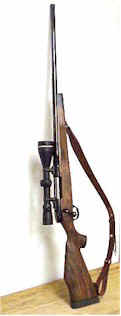 What can I say ? This gun is designed to make you smile. The cartridges look like they’ve been injected with steroids, there’s enough muzzle blast and muzzle flash to clear adjoining shooting benches, and it will leave a lasting impression on the shooter. By the same token, it is not an impractical toy, nor a waste of time for the serious sportsmen. The Weatherby .416 is a great shooter, great hunting rifle and has all the extra punch necessary for large and dangerous game. I think if I were in a situation that truly warranted the use of at least a .375 H&H, I’d skip the .375 and go to this .416. Why not, the felt recoil is less than a Winchester Model 70 in .375 H&H and it packs a lot more punch. For people who write to me and ask what will work for monster size bear and giant moose, I normally say “I don’t know”. Now I can stop saying that, this should definitely work.
What can I say ? This gun is designed to make you smile. The cartridges look like they’ve been injected with steroids, there’s enough muzzle blast and muzzle flash to clear adjoining shooting benches, and it will leave a lasting impression on the shooter. By the same token, it is not an impractical toy, nor a waste of time for the serious sportsmen. The Weatherby .416 is a great shooter, great hunting rifle and has all the extra punch necessary for large and dangerous game. I think if I were in a situation that truly warranted the use of at least a .375 H&H, I’d skip the .375 and go to this .416. Why not, the felt recoil is less than a Winchester Model 70 in .375 H&H and it packs a lot more punch. For people who write to me and ask what will work for monster size bear and giant moose, I normally say “I don’t know”. Now I can stop saying that, this should definitely work.
I know that’s too large of an objective bell hanging off the scope to the left, I stole the Leupold 3-10X50mm Vari-X III, temporarily, from my .338-378. A more typical selection would be a 1.5 – 6X scope with a small bright objective, and perhaps even a quick disconnect system. A couple of reasons I didn’t go that route: a) the gun has no metallic sights, so I’d be looking a little foolish if I quick disconnected the scope in hopes of getting a better view of a charging chipmunk, b) since I needed to borrow the mounts from my .338-378 anyway, I figured why not grab the scope as well.
I need to get a little more experience with the gun before I make a more permanent scope selection. I know the .416 shoots too flat to scope it like a .458 Winchester, but then again the .416 is still used to hunt for the same type of oversized animals, at relatively short ranges. Maybe there is a Burris 1.5-6X Electro Dot in the near future that might work well on both the Marlin and the Weatherby…not sure. I did throw a bore sight on the rifle when I transferred the scope and mounts from my Accumark, unfortunately, I had to make a choice of either a .458″ or a .375 bore” bore sight spud. The .458″ was too big, but the .375″ drooped in the barrel, so I went with the .375″, guessed at the amount of droop, cranked the scope into alignment, and hoped for the best. I also ordered a .35 – .45 spud fromBrownells for the next time around.
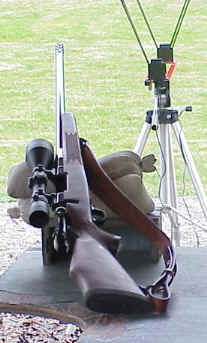 If you’ve read any of my articles on the .257 Weatherby Magnum, or the .338-378 Weatherby Magnum, you know I’ve commented on how well these rifles manage recoil. Between the drop at the heal that converts rearward motion into more of a pushing rotation, and the presence of a high quality recoil pad, these guns are designed to handle large Weatherby cartridges. Even so, I was less than certain this would carry through to the .416.
If you’ve read any of my articles on the .257 Weatherby Magnum, or the .338-378 Weatherby Magnum, you know I’ve commented on how well these rifles manage recoil. Between the drop at the heal that converts rearward motion into more of a pushing rotation, and the presence of a high quality recoil pad, these guns are designed to handle large Weatherby cartridges. Even so, I was less than certain this would carry through to the .416.
Factory 400 grain loads calculate out to about 90 ft/lbs of recoil – or about 75% more than a .375 H&H. In the picture above, you’ll note the muzzle brake is off the gun. This was the configuration of the gun only when it was getting stuffed in, or tugged out of, a too short 48″ case. In the picture to the right, where I’m preparing to blow up my chronograph, the muzzle brake is on; which is where it remained whenever the gun was out of the case. The only comment I feel compelled to make is never, never…never remove the muzzle brake with the gun removed from its case.
I’ve been around guns for a long, long time, but there is always a sense of anticipation that comes with firing off a new gun, and a new round, for the first time. After coming to grips with the reality I wasn’t going to get anyone else to go first, I went ahead and squeezed the trigger. Interesting. The butt came straight back. Unlike the mile high muzzle climbing posture of the .338-378, the barrel rose only about 4″ or 5″. My thumb, quickly making contact with my cheekbone, immediately cleared my sinuses, and reminded me I needed more eye relief. Neat.
If you’re interested, I included a short MPG clip of the first shot – a little movie I like to call “Yikes” narrated with my wife, at least at the closing comment. (Works best with the MS Media Player, Real Player tends to skip at the muzzle blast sound). Fortunately this gun, as the case with my other Weatherby’s, was a snap to shoot. Recoil, while attention getting and entertaining, was not in anyway punishing to the shooter. It is a loud gun, however, and a throws a large pressure wave to the sides.
 The Mark V action is huge. The bolt is secured with 9 locking lugs and it is designed to withstand up to 200,000 CUP before bursting, about three times the industry standard. Because the 9 locking lugs are arranged in groups of three spaced equally around the bolt, only 54 degrees of rotation is required to open the action.
The Mark V action is huge. The bolt is secured with 9 locking lugs and it is designed to withstand up to 200,000 CUP before bursting, about three times the industry standard. Because the 9 locking lugs are arranged in groups of three spaced equally around the bolt, only 54 degrees of rotation is required to open the action.
A 26″ #3 contour barrel is capped with a muzzle brake. The brake is included with all .416 and .460 Weatherby rifles and optional on other calibers. It is very efficient with a 55% reduction in felt recoil. The gun feels very solid, very smooth, and the nose heavy barrel holds steady on the target. The gun is big is size, but it doesn’t feel like a large unwieldy firearm. The adjustable trigger was set to 4.5 lbs as received from the factory. After some breaking in, I’ll follow the simple Weatherby adjustment procedure, and drop that down to as close to 3 lbs as possible.
Securing scope mounts was a less than gratifying project. The dual dovetail base originally recommended by Leupold, and purchased from Midway USA, didn’t come close to fitting even the fastener positions. I believe they were intended for a 1958 Pontiac convertible with air conditioning. I borrowed a set from my SB prefixed serial number .338-378 where at least fastener spacing was correct. High mounts cleared the barrel, the ocular had a lot of room, but there was only a .050″ space under the objective bell.
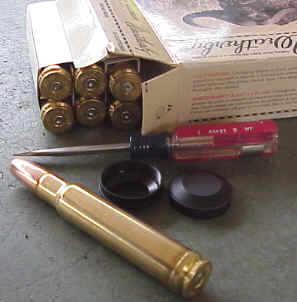 I couldn’t get the scope back far enough in the mounts for proper eye relief and shoulder fit. I also had to crank the scope tower vertical adjustments out more than I would have liked, to get shots on target.
I couldn’t get the scope back far enough in the mounts for proper eye relief and shoulder fit. I also had to crank the scope tower vertical adjustments out more than I would have liked, to get shots on target.
The borrowed system has a front dovetail and an adjustable rear mount. This set up never shot loose on the .338-378 and it didn’t shoot loose on the .416. Still, I will probably try a set of Burris rings and mounts specifically intended for the long Mark V action, and make use of offset ring bushings (if still required) to center the optics while centering the scope. To the left is at least one good reason to bore site, and not try to chase holes around a target while briskly burning your way through an $80 box of cartridges. The scope lagged in adjustment; too many clicks for too little movement.
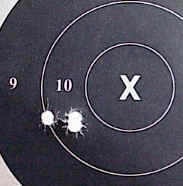 It took about 3 scope shifts to get close to the bullseye, which is where I left off, at least until I can get the scope and mounts sorted out. Generally speaking, I try to install the scope to optical center when bore sighting, to allow maximum adjustment at the range for bullet weight and powder load variations. For whatever reason, I wasn’t able to achieve this alignment with this particular scope/mount/ring setup.
It took about 3 scope shifts to get close to the bullseye, which is where I left off, at least until I can get the scope and mounts sorted out. Generally speaking, I try to install the scope to optical center when bore sighting, to allow maximum adjustment at the range for bullet weight and powder load variations. For whatever reason, I wasn’t able to achieve this alignment with this particular scope/mount/ring setup.
The first group went low 6″ and 8″ left, then after an adjustment even with the bullseye and 5″ left, then this three shot group. At 3/4″ center to center at the widest point, I think I’m okay with the accuracy the gun can deliver, however, I’m not sure I could hammer these out all day long from a bench. After firing 15 rounds or so in a relatively short period of time, the muzzle blast and pressure waves bounced me around so much I was going to take a nap. In fact, I may have taken a nap, but just couldn’t remember. Under hunting conditions with a couple of rounds fired, this would not be an issue….not the nap….the noise.
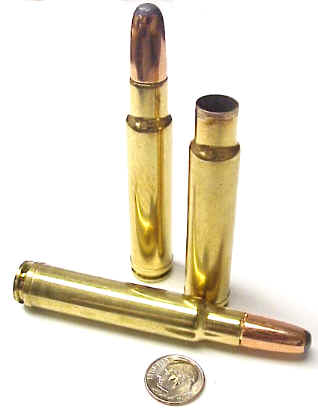 I’m very much looking forward to getting to the range with handloads. This is an easy cartridge to load, and cost effective. Excellent bullets over full up loads run about $25 per box of 20 rounds. Even if handloading wasn’t an option, the factory loads aren’t a performance slouch within the factory loads either.
I’m very much looking forward to getting to the range with handloads. This is an easy cartridge to load, and cost effective. Excellent bullets over full up loads run about $25 per box of 20 rounds. Even if handloading wasn’t an option, the factory loads aren’t a performance slouch within the factory loads either.
The factory .416 round nose, loaded with a 400 grain soft point is rated at 2,700 fps. Ambient temperature at the range was 62°F, and the lowest reading on the chronograph was 2,710 fps. This was the day’s final three shot string. I don’t know if the .416 will have the same potential for improved velocity as the other Weatherby cartridges I’ve worked with, particularly the .338-378, but I certainly hope so.
Ambient temperature at the range was 62°F, and the lowest reading on the chronograph was 2,710 fps. This was the day’s final three shot string. I don’t know if the .416 will have the same potential for improved velocity as the other Weatherby cartridges I’ve worked with, particularly the .338-378, but I certainly hope so.
At the moment I’m very interested in working with the 350 grain Barnes X bullet, to see if I can meet a safe load goal of 3,000 fps. The bullet has a very high ballistic coefficient (.521) and retains a great deal of velocity and energy at extended ranges. Factory ammo with this bullet creates over 6300 ft/lbs of muzzle energy, retains 3200 ft/lbs of it out to 500 yards and slows by only 800 fps. Zeroed at 200 yards, the bullet is 1.7″ high at 100 yards and 7″ low at 300 yards. I believe increasing velocity to 3000 fps would reform the trajectory curve and significantly extend the useful range of the cartridge. The increased speed would also raise muzzle energy to almost 7000 ft/lbs.
This cartridge will require a slightly different technique than the smaller bore cases based on the .378 WM. Rather than the slowest powder, the .416 seems to like medium burn rates perhaps more in keeping with a .243 than a large capacity magnum.
The .45/70 Marlin 1895G Guide Gun
 I own another Marlin, a well worn 336 chambered for the .30/30 cartridge. If there is anything remarkable about the 1895G model, it would be the appearance of an incredibly short overall length and the very large bore. I used the word “appearance” because at 37″, the 1895G is only 1.5″ shorter than a 336 saddle carbine. The very thick forend and thick barrel may contribute to the stubby appearance.
I own another Marlin, a well worn 336 chambered for the .30/30 cartridge. If there is anything remarkable about the 1895G model, it would be the appearance of an incredibly short overall length and the very large bore. I used the word “appearance” because at 37″, the 1895G is only 1.5″ shorter than a 336 saddle carbine. The very thick forend and thick barrel may contribute to the stubby appearance.
The gun is very neutral in balance. While the gun is light at 6.75 lbs, it feels solid and is easy to hold on target. The sights are very clean and have a wide range of adjustment. The front sight is hooded for better centering of the bead and to prevent glare in bright sunlight.
I wanted to try some of the more recent hot loads being produced for the .45/70, like those from Garret, but I wasn’t unable to pick them up in time for use over the weekend. In fact, I had a difficult time getting any type of reasonably priced Remington or Winchester Ammo. I finally located some Remington 300 grain JHP Express loads at $23/box of 20, or about half the price of low pressure ammo with premium bullets.
I don’t know why Remington labels this ammo “Express” – MV is rated at 1800 fps out of a 22″ barrel. In addition, this is low pressure ammo designed for use in any rifle chambered for the .45/70, including antiques in shootable condition. There also seemed to be a quality issue that I will cover a little further along.
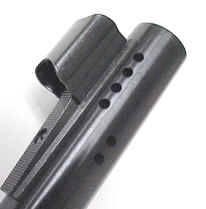 Here’s a little closer look at the ramped and hooded front sight, as well as the factory porting Marlin provides on these rifles. During firing, muzzle flash was notable with flames exiting to the front and sides of the barrel. The little rifle was fired by several of us, including my wife, with all agreeing the gun has minimal recoil. It seems to me I’ve fired some 405 grain black powder loads in the past from relatively heavy military rifles, which also didn’t recoil very much. Maybe higher pressure loads would have been different. In any case, I have to congratulate Marlin for making such an easy to handle little rifle.
Here’s a little closer look at the ramped and hooded front sight, as well as the factory porting Marlin provides on these rifles. During firing, muzzle flash was notable with flames exiting to the front and sides of the barrel. The little rifle was fired by several of us, including my wife, with all agreeing the gun has minimal recoil. It seems to me I’ve fired some 405 grain black powder loads in the past from relatively heavy military rifles, which also didn’t recoil very much. Maybe higher pressure loads would have been different. In any case, I have to congratulate Marlin for making such an easy to handle little rifle.
I did a quick check and came up with 28 ft/lbs of recoil, or around .300 Winchester Mag territory, so the factory porting must really efficiently curb recoil for the rifle to be so comfortable to shoot.
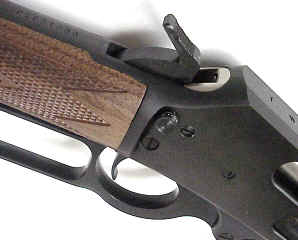 Compared to my old 336, the 1895G is positively outstanding. The walnut stock is straight grained, but flawless, under an attractive satin finish weather proof coating. The checkering may not have the fine lines per inch of a custom job, but the cuts are clean and borderless.
Compared to my old 336, the 1895G is positively outstanding. The walnut stock is straight grained, but flawless, under an attractive satin finish weather proof coating. The checkering may not have the fine lines per inch of a custom job, but the cuts are clean and borderless.
The button located straight down from the hammer is a cross bolt safety, and the receivers with their Marlin closed top still shipped tapped for aftermarket sights. The only thing that spoiled ownership a little bit were some bright spots around screw holes that looked to be caused by sloppy assembly and someone using the wrong size bit in a power driver. I know I may sound picky, but I like to be the one to screw up my own guns. Disassembly for receiver end cleaning is easy; pull the lever attaching screw and lever, pull the bolt out from the rear, and catch the falling ejector. This model has Ballard cut rifling rather than Marlin’s Micro-Groove. The fewer and deeper cuts work better with cast lead bullets that are frequently used with the .45/70 cartridge and will still stabilize jacketed bullets.
 The picture on the right is a riddle, more specifically, “Why isn’t Joe in any of them ?”. Answer – Because my wife on the left, and my son Rich on the right, wouldn’t give the gun back. The Marlin is fun to shoot.
The picture on the right is a riddle, more specifically, “Why isn’t Joe in any of them ?”. Answer – Because my wife on the left, and my son Rich on the right, wouldn’t give the gun back. The Marlin is fun to shoot.
I think this suggests how manageable the recoil is from this large cartridge, in this very small rifle. I actually did get to shoot the Marlin, after wrapping up the data collection on .416. By that time, the .45/70 felt like a pop gun with a lot of flash and roar, but very little recoil. My eyes typically don’t cooperate with metallic sights beyond handgun ranges, especially when the bead makes the entire target disappear, but the sights on the Marlin were acceptable.
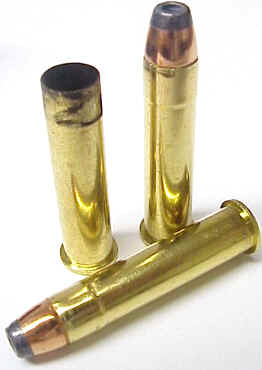 Before I press on, I wanted to offer a few comments on the 300 grain Remington Express loads. For lightly loaded cartridges, they left a lot of residue in the bore, and threw quite a bit out of the barrel. It wasn’t unburned powder, just a lot of carbon. In fact, you can see the coating on the fired case to the right.
Before I press on, I wanted to offer a few comments on the 300 grain Remington Express loads. For lightly loaded cartridges, they left a lot of residue in the bore, and threw quite a bit out of the barrel. It wasn’t unburned powder, just a lot of carbon. In fact, you can see the coating on the fired case to the right.
I was trying to remember why this all looked very familiar, when it dawned on me my .45 Long Colt Ruger did the same thing when I was shooting low pressure factory ammo. Because this cleared up in the Ruger with hotter handloads, I theorized the residue was caused by light crimps, low pressure and a less than optimal chamber seal. I’ll note my findings when I shoot some handloads through the gun.
My real problem with the ammo, other than I thought I’d need a mallet to push the rounds through the loading port on the side of the Marlin’s receiver, were the giant swings in recorded velocity with the chronograph screens 12′ and finally 15′ from the muzzle. While the low to high swing for the .416 was a total of 15 fps, the following represents 10 .45/70 rounds fired in succession:
-
1647
-
1757
-
1562
-
1515
-
1448
-
1649
-
1733
-
1634
-
1558
-
1712
A variance of 309 fps!. The load is rated by Remington as 1810 fps out of a 24″ barrel. Now I’m dying to see if the problem is too short of a barrel coupled with powder that burns too slow, or too soft of a crimp, or….
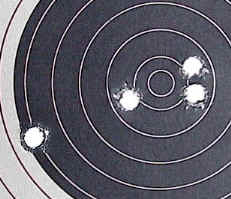 This 4 shot group is about the best for the day. The inside 3 are about 1″ center to center, but including the outside, the group is approximately 2.5″. I need to count the far hole because it was suppose to be the start of a new group…and everyone was watching so I’d never have gotten away with excepting it from the measurement. I believe the gun is capable of 2.5″ – 3.5″ with open sites, my eyesight and a lot of concentration.
This 4 shot group is about the best for the day. The inside 3 are about 1″ center to center, but including the outside, the group is approximately 2.5″. I need to count the far hole because it was suppose to be the start of a new group…and everyone was watching so I’d never have gotten away with excepting it from the measurement. I believe the gun is capable of 2.5″ – 3.5″ with open sites, my eyesight and a lot of concentration.
I want to scope this gun with a compact 1.5x – 5x or 6x on quick detachable mounts. It’s an appropriate setup for this type of gun. I’d also like to see how tight of a group the gun will shoot with an optical boost. My Model 336 in .30/30, with it’s bore dark spot, won’t shoot under 4″ – 5″ under any conditions, but it’s dropped a lot of game. I always chalked this up to the bore condition as well as anticipated accuracy from a lever action rifle. I believe the 1895 will consistently shoot much tighter groups.
Conclusion
I really like both of these guns and I believe both constitute a great value. I don’t believe they are redundant to anything else I own, and I look forward to using both in the field. I see a lot of potential in these cartridges and spending some time on load development will be both enjoyable and productive. I’m told I can get set up with a quality African hunt for the price of an Elk hunt in New Mexico, maybe it’s time to find out.
Thanks,
Joe
Editorial Note: While at the range, the whole group had the privilege of signing a petition designed to place a California Constitutional Amendment on the ballot during the next general election. The initiative is very simple. If approved by voters, it would provides public scrutiny of any new laws that impact the Second Amendment to the same degree as freedom of speech and freedom of the press. County, city and other laws would be preempted by state law in issues of firearm regulation. The initiative would not limit the State from regulating the acquisition and possession of firearms by: felons, minors, the mentally incompetent, and any person subject to restraining orders based upon their own violent conduct.
As you are probably aware, the general public isn’t behind the “Disarm America” drive that has been manufactured and manipulated by the White House. Public poll after poll indicates the far greater majority does not support the current rash of government sponsored law suits that are designed to circumvent public opinion, public scrutiny and the right of the voter.
For more information, please see www.vetothegovernor.org . Unlike an earlier effort from this group, the current initiative is very mainstream, it goes right to the heart of the current political problem with very simple language, and has a good opportunity to pass with any group of reasonable voters. They need 700,000 signatures to get this initiative on the ballot for the next general election and time is of the essence. Please, help with this effort, we need to reverse the momentum.

Email Notification